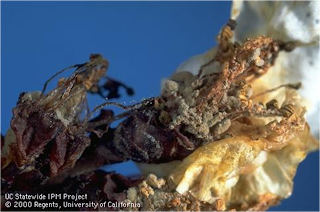Brown Rot or Bacterial Blast?
I have had a few calls regarding blossom dieback within almond trees. In many orchards, especially in Northern Merced, I have seen dried, crispy blossoms still stuck to the tree. In some cases, this may be brown rot, but in a year where we had a cold snap during bloom, this could also be bacterial blast. How do we tell the difference?
 |
| Figure 1: Brown rot blight of an almond blossom. Note the grayish brown fuzz found at the base of the blossom. |
Brown rot will kill blossoms and will often move into the spurs and branches on the tree. As temperatures warm up, cankers form on the wood which sometimes cause gumming. These cankers serve as an over-season resting place for the fungus. Even more obvious than cankers is the formation of light brown to gray fuzz on the jacket or at the base of the flower (Figure 1). This "fuzz" is the spores of the fungus.
Bacterial blast is a blossom blight that is caused by the bacteria Pseudomonas syringe. This is the same bacteria that causes bacterial canker and bud drop. Found naturally all over the tree's surface, this bacteria is an opportunistic pathogen, meaning it will not affect a healthy tree. When a tree is stressed from nematodes (particularly ring nematode), poor soil conditions, lack of nutrients, or an extreme frost event, this bacteria makes it way into the tree's tissues through cracks and natural openings killing affected tissues (Figure 2).
| Figure 2: Bacterial Blast of almond blossoms. Photo courtesy of M. Moran. |
To determine if the dead blossoms in your almond trees was from blast or brown rot, ask yourself these questions:
1). Did I spray for brown rot this year?
2). Am I seeing the dead blossoms across all my varieties?
3). Are the trees stressed in some way or located on sandy or extremely heavy soil?
If you answered "yes" to all of these questions, most likely the blossom death is due to bacterial blast. To confirm the diagnosis, place a few blossoms in a humidity chamber for a day or two (Note: A homemade humidity chamber can be made with an airtight plastic container with a wet paper towel). These conditions will trigger blossoms infected with brown rot to sporulate, which will be indicative by brown fuzz forming around the infected flowers. If no fuzz is found, most likely the culprit was bacterial blast.
